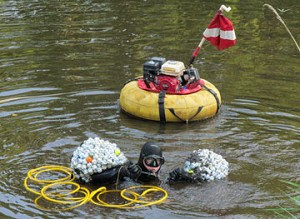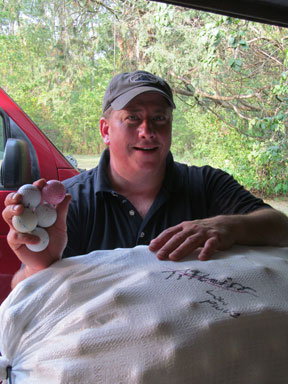20,000 Leagues Under The Sea? Nope. 20,000 Golf Balls!
By Will Brogan
By now you’ve seen a feature or two on the Golf Channel or maybe ESPN detailing the lives of “golf ball divers”. Usually, those features take place in the Southern United States, as the warm climate and potential for omnipresent alligators create a dramatic focus for those features. However, did you know that golf ball diving has been going on for just as long right here in the Twin Cities area?
In the 1930’s, Scott Lokken’s father and uncle began to dive for golf balls as a part time job. Scott joined the family business as soon as he could, learning how to dive for golf balls at age eleven. Now in his fifties, Scott has made golf ball diving his full-time job since the mid-1980s, despite the abbreviated season in the Upper Midwest.
In the early months of the season, Lokken will dive two to three times a week, and spend the rest of his time processing (sorting) golf balls. From now until the end of the season, however, Lokken will dive just about every day. There’s a simple reason: accumulation. The longer Lokken waits to scour a lake for lost balls, the more he’ll find.
As one might expect, the Titleist Pro V1 is the most sought-after ball on the “recycled” market, though Scott says that brands like TopFlite and Pinnacle actually last longer under water thanks to their harder covers. “Pro V’s, Pentas, and stuff like that actually stain faster because of their softer covers,” says Lokken.
Lokken also took the time to explain his diving and recovery tactics, “The first thing that you want to do is hit the bottom of the hill. Every pond is different, but you’ll want to start at the very bottom. Use a grid pattern and cover the “hot spots”, which would be where balls typically enter the water. Normally, I’ll only hit a pond once a year, but it depends on how much play it gets.”
Cleaner and deeper water are pluses for Lokken, who usually has to resort to feel to find the balls thanks to minimal visibility in murky waters. His “favorite” courses to dive on include Deer Run, Troy Burne, Prestwick, and Oak Glen, though he doesn’t get to play many of his favorite tracks that often. “I’ve only played once this year,” Lokken told me. With such a long and warm golf season this year, it’s no surprise that there are more balls to be found in the lakes than Lokken cares to hit into them!
Another neat aspect of his business, which can be found on e-Bay or at www.thegolfballshop.com, is that Lokken has never purchased a sleeve of balls in his entire life! Why would he if he can find so many that are still in mint or near-mint condition?
Still, Lokken warns of the dangers of golf ball diving, as it is more dangerous than one would expect. A snapping turtle once got the better of Lokken’s thumb, though the turtle didn’t do any permanent damage. Obviously, diving in the Southern United States brings alligators and other perilous animals into play, but Lokken will warn you that drowning is the number one fear of all divers. “It does happen,” Lokken says, as he unfortunately served as a field expert in a wrongful death diving case last year.
Given the lack of visibility, it is very easy to get stuck under water, so those considering the profession need a great deal of training before embarking on the wetlands alone. Open water training and working with an experienced golf ball diver are two “absolute” entrance requirements to the profession, and equipment will run roughly three to four thousand dollars.
Still, it’s a worthwhile venture for Lokken, as he’ll typically net five to six thousand balls a day. His personal record was gathered at Deer Run a few years ago, where he captured over 21,300 balls in a single day. That’s more than one ton! After sorting and cleaning the balls, he’ll sell them (with free shipping) for a solid after-market wholesale price on his e-Bay site.
Golf balls aren’t the only equipment Lokken has found in Minnesota’s golfing lakes. On three separate occasions, Lokken has found entire bags of clubs! In one case, he offered to return a bag to the owner, as Lokken found his wallet in the bag. “He told me I could keep the bag, he just wanted the wallet!” Lokken says of that instance.
Another time, he was diving along the bank of a lake and found a one iron, followed by every single club in an iron set down to the pitching wedge, all spaced about twenty yards apart. Now it’s one thing to toss a putter or bag into a lake in a momentary fit of golfing anger, but that takes some determination to rid yourself of an entire iron set one-by-one in the same lake!!
Scott Lokken has taken this part-time gig that he learned from his father and uncle and turned it into a full time career. With such successful dives, and the memories he has, Lokken truly does enjoy life “under the sea”!































